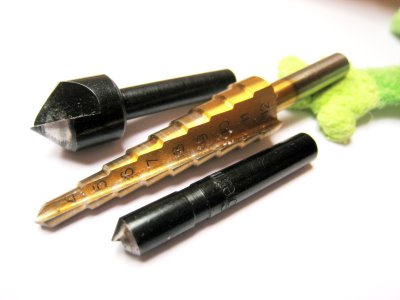This MAKE: Blog piece is about this page on the subject of making holes in panels which are, and here's the tricky bit, both where, and how big, you want them to be. This is a task for which a step drill is, indeed, very helpful.
I don't actually own any step drills. I cannot imagine why this is, so I just added a set to my eBay sniping list. I do, however, own a couple of tapered reamers, which can achieve much the same thing. They give slightly countersunk hole-sides, which you may not want. But because they're 100% hand operated, they offer finer hole size control, and a much greater risk of repetitive strain injury.
(I used the reamers a lot when getting 80% through construction of my Thing-a-ma-kit, during our holiday.)
The Make piece says "I also sense a nibbler in his future". OK, maybe, for panel work. But I've got a genuine Adel nibbler, and it's almost never been useful for anything at all.
Oh, I've often found myself thinking "Aha! The nibbler will, at last, pay its way!"... but almost every single bloody time, whatever it was I wanted to cut little rectangular bite after little rectangular bite out of was 0.002mm too thick (I believe that's 7.87 RCH, in Imperial units) to fit in the nibbler's jaws.
So back I go to the Dremel or the coping saw or the club-hammer and cold-chisel, again.

18 January 2009 at 12:31 am
Unibits are awesome. I learned about them when I was building panels for industrial control equipment. (That's also where I learned about the RCH).
18 January 2009 at 8:46 am
While I have long known of the RCH I did not get the abbreviation until I googled it. Thanks for the laugh.
18 January 2009 at 12:25 pm
I never got why they had to be red, myself.
18 January 2009 at 1:48 pm
Personally, I just use brad point drill bits if I need to cut a neat hole in a panel. Mind you, most of the panels (well, all of them) have been either plastic or aluminium. Don't know how well that would work in steel.
18 January 2009 at 2:58 pm
Perhaps Fuzzy, it's due to their rarity. In the Navy we just called em CH's we never were particular about color.
18 January 2009 at 3:54 pm
Somewhat unsurprisingly, wikipedia has an article on RCH that, er, reveals all.
19 January 2009 at 6:36 am
Going back to Cold Chisel is always a good plan. Wait, what?
19 January 2009 at 6:41 am
I could actually do with a prop reamer myself...
19 January 2009 at 8:03 am
Just how shallow is your nibbler? I can chop up coins with the cheap little one I got for Radio Shack. On the other hand most American coinage tends on the thin side, being as a rule under a dollar if in common use. Still, thicker than that would be severe for sheet metal.
19 January 2009 at 3:41 pm
Just how shallow is your nibbler?
Very. It's always reading gossip magazines. (Try the veal!)
Actually, I think the maximum capacity of the non-Adel nibblers actually is larger (though they're less robust and you probably can't replace the punch). I just eyeballed it, and the Adel can only manage about 1.7mm. (I think the official maximum capacity is .0625 inches, which is about 1.6mm.)
There's about another 1.5mm of actual travel in the mechanism, though, so you could probably hack an Adel nibbler into managing at least 2.5mm, material-you're-cutting permitting, of course.
20 January 2009 at 3:19 pm
Looks like my off brand gets about 3mm give or take. Still, it's a little lacking in leverage so your hand really start to ache if you make a habit of cutting anything anywhere near that thick.
20 January 2009 at 7:36 pm
Woohoo! The Thingamagoop. Does it go "Bloop" when only 80% assembled?
20 January 2009 at 8:10 pm
Yep - I just haven't quite stuffed it into the enclosure yet. It's a quite simple circuit, but I was still rather surprised when I turned the board on for the first time and it seemed I hadn't screwed anything up.